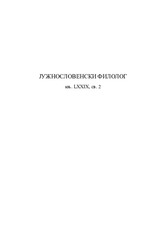ОД БАНА ДО ХЕРЦЕГА: СТРАНИ ЛЕКСИЧКИ СЛОЈЕВИ У ЋИРИЛСКИМ ПОСЛОВНОПРАВНИМ АКТИМА СРЕДЊОВЕКОВНЕ БОСНЕ И ХУМА
FROM BAN TO HERZEG: FOREIGN LEXICAL LAYERS IN CYRILLIC BUSINESS AND LEGAL ACTS OF MEDIEVAL BOSNIA AND HUM
Author(s): Nataša Ž. DraginSubject(s): Cultural history, Social history, Historical Linguistics, South Slavic Languages, 6th to 12th Centuries, 13th to 14th Centuries, 15th Century
Published by: Институт за српски језик Српске академије наука и уметности
Keywords: Bosnia; charters and letters; Hum; loanwords; Old Serbian language;
Summary/Abstract: This paper deals with foreign lexemes attested in business and legal acts created in the area of Bosnia and Hum in the period ranging from the late 12th to the late 15th century, with the aim of shedding light on their origin, the domain of use and degree of adaptation within the Old Serbian language. In addition to the younger lexical layer, the focus was also on the old loanwords from the Proto-Slavic language. The excerpted corpus proves a strong infl uence of the Greek language, which, in addition to the fi eld of ecclesiastical terminology, also left its mark in the naming of occupations, money and measures, and to a lesser extent in the legal sphere and secular titles, while it also mediated in the adoption of certain names of the months of the year. In addition to the calendrical lexicon, Latin and Italian covered the fi eld of commerce, law, public services and organization of cities and fortifi cations. To a certain extent, the sources also provided insight into the ecclesiastical terms of Latin origin, as well as the Oriental titles adopted from Turkish. The Oriental infl uence appears sporadically even in the domain of politics and trade, whereas the words from the German and Hungarian languages are found only in individual examples. The incomplete adaptation observed within several thematic groups testifi es to the ongoing and still current processes of establishing different terminological subsystems. Representing different chronological layers in the structure of the lexicon of the Old Serbian language, the lexicon of foreign origin thus largely refl ected the specifi c political, economic and cultural context and infl uences that shaped the history of these areas in the Middle Ages.
Journal: Јужнословенски филолог
- Issue Year: 79/2023
- Issue No: 2
- Page Range: 63-90
- Page Count: 28
- Language: Serbian

